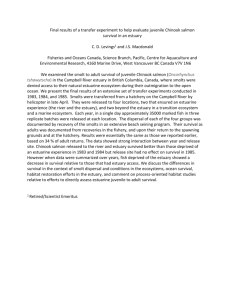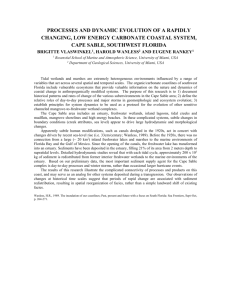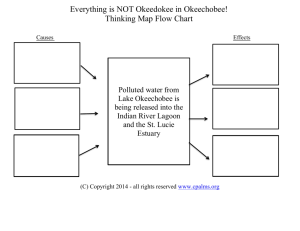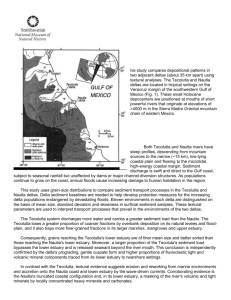SMALL ECOLOGICAL PROJECT GRANT : APPLICATION FORM
advertisement
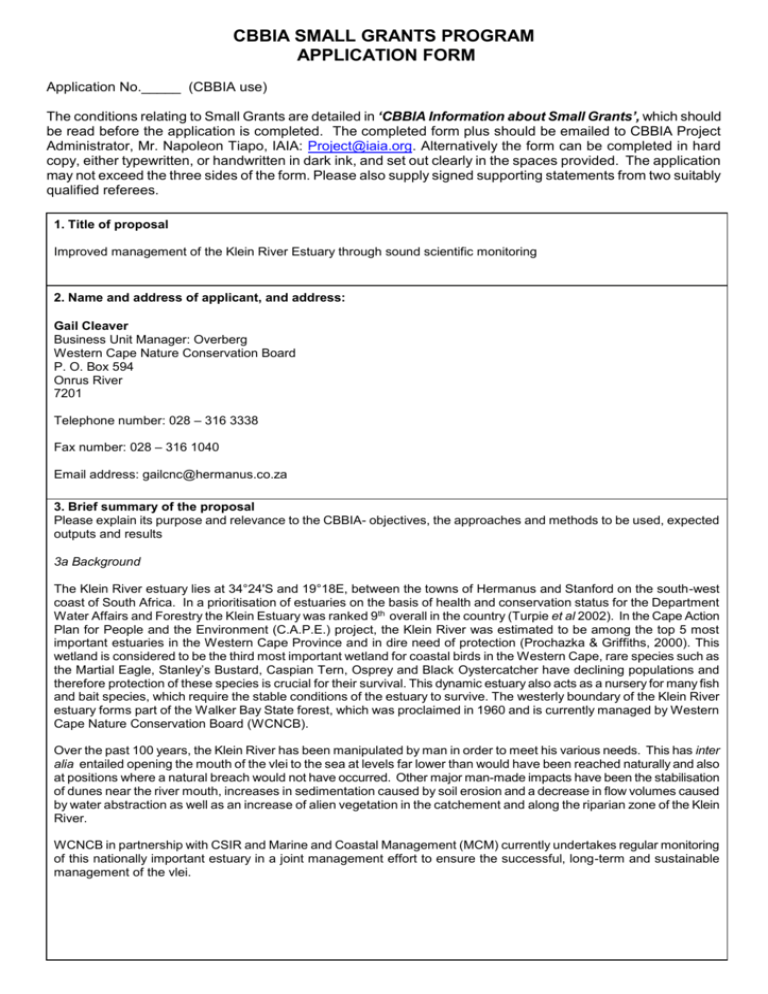
CBBIA SMALL GRANTS PROGRAM APPLICATION FORM Application No._____ (CBBIA use) The conditions relating to Small Grants are detailed in ‘CBBIA Information about Small Grants’, which should be read before the application is completed. The completed form plus should be emailed to CBBIA Project Administrator, Mr. Napoleon Tiapo, IAIA: Project@iaia.org. Alternatively the form can be completed in hard copy, either typewritten, or handwritten in dark ink, and set out clearly in the spaces provided. The application may not exceed the three sides of the form. Please also supply signed supporting statements from two suitably qualified referees. 1. Title of proposal Improved management of the Klein River Estuary through sound scientific monitoring 2. Name and address of applicant, and address: Gail Cleaver Business Unit Manager: Overberg Western Cape Nature Conservation Board P. O. Box 594 Onrus River 7201 Telephone number: 028 – 316 3338 Fax number: 028 – 316 1040 Email address: gailcnc@hermanus.co.za 3. Brief summary of the proposal Please explain its purpose and relevance to the CBBIA- objectives, the approaches and methods to be used, expected outputs and results 3a Background The Klein River estuary lies at 34°24'S and 19°18E, between the towns of Hermanus and Stanford on the south-west coast of South Africa. In a prioritisation of estuaries on the basis of health and conservation status for the Department Water Affairs and Forestry the Klein Estuary was ranked 9th overall in the country (Turpie et al 2002). In the Cape Action Plan for People and the Environment (C.A.P.E.) project, the Klein River was estimated to be among the top 5 most important estuaries in the Western Cape Province and in dire need of protection (Prochazka & Griffiths, 2000). This wetland is considered to be the third most important wetland for coastal birds in the Western Cape, rare species such as the Martial Eagle, Stanley’s Bustard, Caspian Tern, Osprey and Black Oystercatcher have declining populations and therefore protection of these species is crucial for their survival. This dynamic estuary also acts as a nursery for many fish and bait species, which require the stable conditions of the estuary to survive. The westerly boundary of the Klein River estuary forms part of the Walker Bay State forest, which was proclaimed in 1960 and is currently managed by Western Cape Nature Conservation Board (WCNCB). Over the past 100 years, the Klein River has been manipulated by man in order to meet his various needs. This has inter alia entailed opening the mouth of the vlei to the sea at levels far lower than would have been reached naturally and also at positions where a natural breach would not have occurred. Other major man-made impacts have been the stabilisation of dunes near the river mouth, increases in sedimentation caused by soil erosion and a decrease in flow volumes caused by water abstraction as well as an increase of alien vegetation in the catchement and along the riparian zone of the Klein River. WCNCB in partnership with CSIR and Marine and Coastal Management (MCM) currently undertakes regular monitoring of this nationally important estuary in a joint management effort to ensure the successful, long-term and sustainable management of the vlei. FIGURE 1: Locality of the Klein River 3b Objectives - Measure the penetration of the seawater into the Lagoon. Evaluate whether salinities are being influenced by changes in runoff. Mouth position has a much smaller influence on estuarine salinity vs reduction in flow. Quantifying the influence of salinity on the submerged vegetation in the Lagoon. Determine of the effects of high water levels before and during the breaching of the mouth. Gather valuable data on the flow of water during a breaching. Verify the complete drainage of the lagoon Compile contour map of the lagoon (2005) References JK TURPIE, JB ADAMS, BM COLLOTY, A JOUBERT, TD HARRISON, RC MAREE, S TALJAARD, L VAN NIEKERK, AK WHITFIELD, TH WOOLDRIDGE, SJ LAMBERTH, R TAYLOR, P MORANT, A AWAD, B WESTON and H MACKAY 2002. Classification and prioritization of South African estuaries on the basis of health and conservation priority status for determination of the estuarine water reserve. Department of Water Affairs and Forestry, Pretoria. PROCHAZKA, K and GRIFFITHS, C 2000. Cape Action Plan for the Environment. Final report of the estuarine component. Summary of proposal, cont. (use this page if necessary) 3c Approaches and methods This monitoring will be undertaken by WCNCB staff and Honorary Nature Conservation Officer’s as follows: Salinity: Monthly survey of salinities of the Klein River Estuary to measure the penetration of the seawater into the lagoon. The measurements should be done at the same predetermined sites. These readings must be taken vertically in the water column at 0.5 m intervals on a spring tide, twice a day if possible, for both the high and low tide. Salinity concentrations should be measured about 1-2 days before breaching in the case of an artificial breaching. Post salinity concentrations should initially be measured at weekly intervals to establish the mixing processes taking place in the estuary. For example, salinity measurements at the end of summer (low flow period) gives a very good indication of estuarine health and the over all impact of flow reduction on the system. Breaching: Measure the berm height at the lagoon mouth (cross section of the sandspit) to determine the lowest point on the berm to assist in decision making when breaching the mouth. A long-term data set on berm levels will also be of assistance in understanding the natural dynamics of the estuary before human intervention occurred and will therefore assist in decisions making. Water Level monitoring during breaching: A permanently fixed vertical water level recorder should be installed, with an electronic pressure sensor with a data logger. Daylight breaching: Monitoring during an early morning breach, the greatest outflows (during the day) would allow for visual monitoring to verify how far scouring takes place upstream of the breaching. Video footage should be taken during the day to establish the effectiveness of the breach. Bathymetry: Use echo sounder to determine the depth of the lagoon and 3 GPS readings (1 fixed point and two on a boat) at each site. These should be undertaken every 3-5 years. Next one due in 2005. This should be carried out when lagoon is full. 3d Expected outputs and results (clear deliverables should be identified) Improved understanding of the estuary dynamics. Sound scientific basis for decision-making regarding the breaching of the lagoon. Continued long-term monitoring on the state of health of the estuary. Information gather will assist in the drafting of a long-term management strategy for the Klein River Estuary. 4. Details of costings and funding requirements Tools and Equipment: 1. Vertical Water Level Recorder R25 000-00 2. Quanta Hydrolab (salinity, pH, conductivity, dissolved oxygen, depth meter) R25 000-00 3. Dumpy level R 4 000-00 4. Video Camera R 6 000-00 R60 000-00 Amount sought from the CBBIA project: R60 000-00 ($10 000-00)* *assumption $1 = R6 5. Names and addresses of two referees: At least one referee should be from a different place of work to the applicant. Referees must send their statements to IAIA before the closing date. Applicants should give the referees details of the proposal. Ms Lara van Niekerk (CSIR) CSIR P.O. Box 320 Stellenbosch 7599 Telephone number: 021-888 2491 Cellular: 082 820 3339 e-mail address: lvnieker@csir.co.za Mr S. Lambert (Marine and Coastal Management) Telephone number: 021-402 3159 Cellular: 082 8683834 e-mail address: lamberth@deat.gov.za 6. Details of other applications (with addresses where appropriate), together with sums sought or awarded, for this proposal. None 7. Brief curriculum vitae (qualifications, employment) for main proposer: Miss Gail Cleaver (ID 720307 0052 082) Work experience: Western Cape Nature Conservation Board Business Unit Manager Overberg Business Unit Conservation Manager Kammanassie and Millwood Nature Reserves Nature Conservator Kammanassie and Millwood Nature Reserves Conservation Trainee Robberg and Keurbooms River Nature Reserves 2003 – current 1997-1998 1999-2002 1996 Qualifications: Magister Technologiae: Nature Conservation (2004) University of South Africa : Department of Nature Conservation College for agriculture, Natural Resources and Environmental Baccalaureus Technolologiae: Nature Conservation (1999) Technikon South Africa National Diploma: Nature Conservation (1996) Technikon South Africa 10.Declaration:I certify that the proposal to which this application refers is not supported through any initiatives other than those listed in ‘6’ (above). I confirm that the results of the work undertaken will be the property of the CBBIA. I also confirm my understanding that acceptance of a grant will imply a requirement for the proposed work to comply with the financial, monitoring and evaluation requirements of the CBBIA Program. Signature: Date: 29 September 2004 FOR CBBIA USE Received/Acknowledged SC: Date / Decision Amount awarded Report/due

